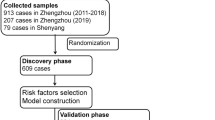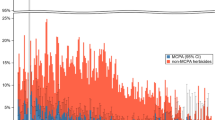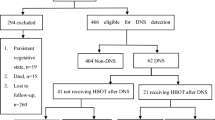Abstract
High-mobility group box 1 (HMGB1) mediates acute lung injury in a mouse model of paraquat poisoning. However, published reports showing a clinically relevant association between HMGB1 and paraquat exposure are lacking. The objective of the present study was to investigate the potential role of serum HMGB1 level as a prognostic marker of mortality in patients with paraquat poisoning in a clinical setting. This retrospective observational cohort study included a convenience sample of 92 patients with acute paraquat poisoning admitted to the emergency room (ER) of The First Hospital of Jilin University between January 2014 and December 2016. Baseline serum HMGB1 levels and other laboratory parameters were measured on admission. Cumulative incidence of mortality during the first 30 days after admission was 50% (n = 46/92). Serum HMGB1 levels were higher in fatalities than survivors (P = 0.015), 30-day mortality increased with increasing baseline serum HMGB1 level (P < 0.001), and higher serum HMGB1 levels were associated with an increase in 30-day mortality on Kaplan-Meier analysis. Multivariate Cox regression analysis identified baseline serum HMGB1 levels, white blood cell count, and serum lactic acid levels as independent prognostic markers of 30-day mortality. These data suggest that serum HMGB1 levels measured on admission to the ER are an independent predictor of 30-day mortality in patients with acute paraquat poisoning.
Similar content being viewed by others
Introduction
Paraquat is an organic compound containing the active ingredient 1,1′-dimethyl-4,4′-bipyridinium dichloride that is widely used as a herbicide. Globally, paraquat is a leading cause of lethal poisoning, particularly in developing countries1,2,3,4,5,6. In fact, oral ingestion of paraquat for deliberate self-harm has become a severe public health problem in several countries1,2,3,4.
Currently, oxidative stress is implicated as the mechanism underlying the toxic effects produced by paraquat. Biotransformation of paraquat in cells results in the generation of reactive oxygen species (ROS) and apoptosis-related molecules, which cause multiple organ dysfunction in humans and animals, mainly involving the lung, kidney, heart, liver, and central nervous system.
Recent evidence suggests that the molecular mechanisms underlying paraquat toxicity include the release of damage-associated molecular patterns, including high-mobility group box 1 (HMGB1), a chromatin-binding protein that can be secreted by necrotic or inflammatory cells. Previously, we reported that a signaling cascade involving HMGB1, toll-like receptor 4 (TLR4), interleukin 23 (IL23), and IL17A mediated acute lung injury (ALI) in a mouse model of paraquat poisoning7. These findings suggest that targeting the HMGB1-TLR4-IL23-IL17A axis represents a potential therapeutic strategy for treating paraquat poisoning. However, published reports showing a clinically relevant association between HMGB1 and paraquat exposure are lacking. Therefore, the objective of the present study was to investigate the potential role of serum HMGB1 level as a prognostic marker of mortality in patients with paraquat poisoning in a clinical setting.
Methods
Study subjects
This study was approved by the ethics committee of The First Hospital of Jilin University and was conducted in accordance with the Declaration of Helsinki. Written informed consent was obtained from all patients on admission to the emergency room (ER).
This retrospective observational cohort study included a convenience sample of patients presenting to the ER of The First Hospital of Jilin University between January 2014 and December 2016 with acute paraquat poisoning, defined as an oral intake of 2–200 mL paraquat during the prior 24 hours. Exclusion criteria were: (1) diabetes mellitus, hypertension, renal failure, or malignancy; (2) >24 hours since oral intake of paraquat; or (3) incomplete follow-up data. Hospitalized patients were followed up to death. Discharged patients were followed up to death or for 30 days. Twenty healthy subjects were enrolled to investigate baseline HMGBI levels in a group of healthy controls.
Sample collection and biochemical analyses
Each patient provided a peripheral venous blood sample (5 mL) during the first 24 hours after admission to the ER. Sera were isolated, frozen, and stored at −80 °C until use. Serum HMGB1 levels were measured using an enzyme-linked immunosorbent assay kit according to the manufacturer’s instructions (Yanhui Biotech, Shanghai, China).
Baseline hematological and laboratory parameters, including white blood cell (WBC), neutrophil, lymphocyte, and platelet counts, hemoglobin, prothrombin time, total bilirubin, albumin, alanine aminotransferase (ALT), aspartate aminotransferase (AST), creatinine, serum amylase, troponin I (cTnI), pH, partial pressure of carbon dioxide (PaCO2), and partial pressure of oxygen (PaO2) were measured using a Hitachi 7600 Clinical Analyzer (Hitachi, Tokyo, Japan), Sysmex CA-7000 System (Sysmex, Kobe, Japan), and Sysmex XE-5000 (Sysmex)8, according to standard protocols.
Statistical analysis
Statistical analyses were conducted using SPSS, v24 (SPSS, Chicago, IL, USA). Values are expressed as mean ± standard error of the mean (SEM) for normally distributed data or median and interquartile ranges for non-normally distributed data. One-way analysis of variance (ANOVA) and the Kruskal–Wallis H test or Mann–Whitney U test were performed to evaluate between-group differences. Chi-squared test was conducted to evaluate between-group differences stratified by gender and in 30-day mortality. A Kaplan-Meier curve was constructed to describe survival. Univariate and multivariate Cox regression analyses were performed to identify predictors of 30-day mortality; results are summarized as hazard ratios with corresponding 95% confidence intervals (CIs). Variables with a P value < 0.1 on univariate analysis were included in the multivariate analysis. P < 0.05 was considered statistically significant.
Results
Study population
This study enrolled 304 patients with an oral intake of 2–200 ml paraquat. A total of 212 patients were excluded. Of these, 21 patients had diabetes mellitus, 29 patients had hypertension. 19 patients had renal failure, 22 patients had malignancy, 104 patients had inadequate follow up data, and >24 hours had passed since the oral intake of paraquat in 17 patients. The remaining 92 patients were included in the final analysis. These patients had a median age of 33.5 years (range: 13–77 years) and 47 were female and 45 were male.
Baseline demographic and clinical characteristics
Patients were divided into tertiles according to their baseline serum HMGB1 levels: tertile 1, HMG1:0.41–6.67 μg/mL; tertile 2, 7.12–11.36 μg/mL; tertile 3, 11.56–15.34 μg/mL. Baseline demographic and clinical characteristics of included patients stratified by HMGB1 tertile are summarized in Table 1. Baseline WBC and neutrophil counts and serum lactic acid levels significantly increased across tertiles from lowest to highest serum HMGB1 levels, while arterial pH decreased.
Comparison of the serum HMGB1 level between fatalities and survivors
Mean serum HMGB1 levels in healthy controls, fatalities, and survivors are shown in Fig. 1. Mean serum HMGB1 level in healthy controls was 0.53 [range, 0.00–1.30] μg/L, and significantly lower than for fatalities or survivors (P < 0.001). Mean baseline serum HMGB1 level was significantly higher in fatalities vs. survivors (11.79 [range, 0.41–15.34] μg/L) vs. 7.51 [range, 0.49–15.20] μg/L, P = 0.015) (Fig. 1).
Comparison of the serum HMGB1 level in females and males
Mean serum HMGB1 levels in females and males are shown in Fig. 2. There was no significant difference in mean serum HMGB1 level between females and males (t = 1.60, P = 0.11) (Fig. 2).
Association of serum HGB1 level with mortality rate
All patients were treated according to standard procedures in the ER. Cumulative incidence of mortality during the first 30 days after admission was 50% (n = 46/92). The ratio of survivors to fatalities in each HMGB1 tertile is shown in Table 2. The 30-day mortality rate was significantly increased across tertiles from lowest (tertile 1, 26.7%; tertile 2, 43.3%) to highest (tertile 3, 78.1%) serum HMGB1 levels. A Kaplan-Meier curve was constructed to describe survival. The log rank test of a difference in survival between tertiles was significant (P < 0.001) (Fig. 3).
Risk factor analysis for 30-day mortality
Multivariate Cox proportional hazards regression analyses identified baseline serum HMGB1 level, WBC count, and serum lactic acid levels as independent prognostic markers of 30-day mortality in patients with acute paraquat poisoning (Table 3).
Discussion
The results of the current study investigating acute paraquat poisoning in humans showed that 30-day mortality was increased in patients with higher baseline serum HMGB1 levels, and baseline serum HMGB1 level was an independent prognostic marker of 30-day mortality in this patient population.
Paraquat is a poisonous herbicide that has toxic effects due to its redox activity. Paraquat induces oxidative damage and cell death by generating ROS, including hydrogen peroxide, superoxide anion, and hydroxyl radicals.
HMGB1 in involved in infection, organ dysfunction and immune responses in acute injury and chronic disease, including myocardial infarction, stroke, acute lung injury, acute liver injury7,9, ischemia–reperfusion injury, sepsis, fibrotic disorders, and cancer10. HMGB1 is an alarmin, with distinct intracellular and extracellular effects. It is present in the cell nucleus and cytoplasm and can be translocated to the extracellular space11. HMGB1can be actively released from cells, including macrophages, monocytes, natural killer cells, dendritic cells, endothelial cells and platelets, or passively produced by necrotic and damaged cells12,13. In the extracellular space, HMGB1 mediates inflammation and chemotaxis12 and has far reaching effects causing remote organ dysfunction in sterile injury14.
Death in paraquat poisoning is usually caused by ALI15,16. The development and severity of ALI is controlled by pulmonary neutrophil infiltration17,18,19. Findings from our previous study revealed that the HMGB1-TLR4-I-L23-IL-17A axis regulated neutrophil infiltration and ALI in a mouse model of paraquat poisoning7. Conversely, administration of HMGB1-specific neutralizing antibodies or the HMGB1-binding antagonist thrombomodulin can rescue mice and rats20,21,22 from lethal sepsis. Taken together, data from our studies and previous animal experiments suggest that neutralization of HMGB1 represents a potential therapeutic option for the treatment of paraquat poisoning. However, the results should be interpreted with caution, as the specific mechanism of action of HMGB1 in humans remains to be elucidated.
The previous reports and findings from the current study suggest an association between HMGB1 and the mechanism of paraquat toxicity, in which HMGB1 may function as a regulator of cytokine, chemokine, and growth factor activity, coordinating the inflammatory and immune response7,23. Further investigations regarding this association are warranted to expand understanding of paraquat toxicity and inform the development of targeted therapeutics.
Some studies have determined that initial leucocyte level and arterial lactate are predictors of mortality in patients with paraquat poisoning17,24,25,26. This is consistent with our findings. Reliable predictors of prognosis are important to inform clinical treatment decision making in this patient population.
This study was associated with several limitations. First, this was a cross-sectional study and cause and effect of HMGB1 in the etiology of paraquat poisoning could not be elucidated. Second, oral paraquat poisoning was based on patient self- report. Evidence suggests that plasma paraquat levels have prognostic value in patients with acute paraquat poisoning27. However, plasma paraquat levels were not measured in the current study as access to testing is limited by time and cost, and most ER physicians do not rely on plasma paraquat measurements for clinical decision making.
In summary, the results of the current study suggest that serum HMGB1 level measured on admission to the ER is a feasible index for assessing the outcome of patients with acute paraquat poisoning, and strategies that decrease serum HMGB1 levels may have role in the management of these patients. Further studies elucidating the role of HMGB1 in paraquat poisoning are required to guide the development of effective clinical interventions.
Data Availability
The datasets generated during and/or analyzed during the current study are available from the corresponding author on reasonable request.
References
Hsu, C. W. et al. Early hemoperfusion may improve survival of severely paraquat-poisoned patients. PloS one 7, e48397, https://doi.org/10.1371/journal.pone.0048397 (2012).
Deng, J., Huo, D., Wu, Q., Zhu, L. & Liao, Y. Xuebijing for paraquat poisoning. The Cochrane database of systematic reviews, Cd010109, https://doi.org/10.1002/14651858.CD010109.pub2 (2013).
Chen, H. W., Tseng, T. K. & Ding, L. W. Intravenous paraquat poisoning. J Chin Med Assoc 72, 547–550, https://doi.org/10.1016/s1726-4901(09)70426-5 (2009).
Kim, S. J., Gil, H. W., Yang, J. O., Lee, E. Y. & Hong, S. Y. The clinical features of acute kidney injury in patients with acute paraquat intoxication. Nephrol. Dial. Transplant. 24, 1226–1232, https://doi.org/10.1093/ndt/gfn615 (2009).
Bromilow, R. H. Paraquat and sustainable agriculture. Pest Manag Sci 60, 340–349, https://doi.org/10.1002/ps.823 (2004).
Li, H. et al. Neuroprotective effects of tert-butylhydroquinone on paraquat-induced dopaminergic cell degeneration in C57BL/6 mice and in PC12 cells. Arch. Toxicol. 86, 1729–1740, https://doi.org/10.1007/s00204-012-0935-y (2012).
Yan, B., Chen, F., Xu, L., Xing, J. & Wang, X. HMGB1-TLR4-IL23-IL17A axis promotes paraquat-induced acute lung injury by mediating neutrophil infiltration in mice. Scientific reports 7, 597, https://doi.org/10.1038/s41598-017-00721-8 (2017).
Ambayya, A. et al. Haematological reference intervals in a multiethnic population. PloS one 9, e91968, https://doi.org/10.1371/journal.pone.0091968 (2014).
Wang, X., Sun, R., Wei, H. & Tian, Z. High-mobility group box 1 (HMGB1)-Toll-like receptor (TLR)4-interleukin (IL)-23-IL-17A axis in drug-induced damage-associated lethal hepatitis: Interaction of gammadelta T cells with macrophages. Hepatology 57, 373–384, https://doi.org/10.1002/hep.25982 (2013).
Bertheloot, D. & Latz, E. HMGB1, IL-1α, IL-33 and S100 proteins: dual-function alarmins. Cellular & Molecular Immunology 14, 43–64 (2017).
Pisetsky, D. S., Erlandsson-Harris, H. & Andersson, U. High-mobility group box protein 1 (HMGB1): an alarmin mediating the pathogenesis of rheumatic disease. Arthritis Res Ther 10, 209, https://doi.org/10.1186/ar2440 (2008).
Lotze, M. T. & Tracey, K. J. High-mobility group box 1 protein (HMGB1): nuclear weapon in the immune arsenal. Nature Reviews Immunology 5, 331–342 (2005).
Harris, H. E., Andersson, U. & Pisetsky, D. S. HMGB1: a multifunctional alarmin driving autoimmune and inflammatory disease. Nat Rev Rheumatol 8, 195–202, https://doi.org/10.1038/nrrheum.2011.222 (2012).
Sodhi, C. P. et al. Intestinal Epithelial TLR-4 Activation Is Required for the Development of Acute Lung Injury after Trauma/Hemorrhagic Shock via the Release of HMGB1 from the Gut. J. Immunol. 194, 4931 (2015).
Eddleston, M. & Phillips, M. R. Self poisoning with pesticides. BMJ (Clinical research ed.) 328, 42–44, https://doi.org/10.1136/bmj.328.7430.42 (2004).
Jeyaratnam, J. Acute pesticide poisoning: a major global health problem. World health statistics quarterly. Rapport trimestriel de statistiques sanitaires mondiales 43, 139–144 (1990).
Kang, C. et al. Absolute lymphocyte count as a predictor of mortality in emergency department patients with paraquat poisoning. PloS one 8, e78160, https://doi.org/10.1371/journal.pone.0078160 (2013).
Butt, Y., Kurdowska, A. & Allen, T. C. Acute Lung Injury: A Clinical and Molecular Review. Arch Pathol Lab Med 140, 345–350, https://doi.org/10.5858/arpa.2015-0519-RA (2016).
Koike, M. et al. Mechanical overloading causes mitochondrial superoxide and SOD2 imbalance in chondrocytes resulting in cartilage degeneration. Scientific reports 5, 11722, https://doi.org/10.1038/srep11722 (2015).
Qin, S. et al. Role of HMGB1 in apoptosis-mediated sepsis lethality. J. Exp. Med. 203, 1637–1642, https://doi.org/10.1084/jem.20052203 (2006).
Suda, K. et al. Anti-high-mobility group box chromosomal protein 1 antibodies improve survival of rats with sepsis. World J Surg 30, 1755–1762, https://doi.org/10.1007/s00268-005-0369-2 (2006).
Yang, H. et al. Reversing established sepsis with antagonists of endogenous high-mobility group box 1. Proc Natl Acad Sci USA 101, 296–301, https://doi.org/10.1073/pnas.2434651100 (2004).
Kang, R. et al. HMGB1 in health and disease. Mol Aspects Med 40, 1–116, https://doi.org/10.1016/j.mam.2014.05.001 (2014).
Li, S., Zhao, D., Li, Y., Gao, J. & Feng, S. Arterial lactate in predicting mortality after paraquat poisoning: A meta-analysis. Medicine 97, e11751, https://doi.org/10.1097/md.0000000000011751 (2018).
Feng, S., Gao, J. & Li, Y. A retrospective analysis of leucocyte count as a strong predictor of survival for patients with acute paraquat poisoning. PloS one 13, e0201200, https://doi.org/10.1371/journal.pone.0201200 (2018).
Zhang, J. et al. The significance of serum uric acid level in humans with acute paraquat poisoning. Scientific reports 5, 9168, https://doi.org/10.1038/srep09168 (2015).
Gil, H. W., Kang, M. S., Yang, J. O., Lee, E. Y. & Hong, S. Y. Association between plasma paraquat level and outcome of paraquat poisoning in 375 paraquat poisoning patients. Clin. Toxicol. 46, 515 (2008).
Acknowledgements
The authors thank Dahai Xu for helpful discussions and suggestions.
Author information
Authors and Affiliations
Contributions
Bailing Yan designed the study. Zuolong Liu and Wei Li collected the data. Feng Chen, Bailing Yan and Dan Li analyzed the data and drafted the manuscript. All authors have read and approved the final manuscript.
Corresponding authors
Ethics declarations
Competing Interests
The authors declare no competing interests.
Additional information
Publisher’s note: Springer Nature remains neutral with regard to jurisdictional claims in published maps and institutional affiliations.
Supplementary information
Rights and permissions
Open Access This article is licensed under a Creative Commons Attribution 4.0 International License, which permits use, sharing, adaptation, distribution and reproduction in any medium or format, as long as you give appropriate credit to the original author(s) and the source, provide a link to the Creative Commons license, and indicate if changes were made. The images or other third party material in this article are included in the article’s Creative Commons license, unless indicated otherwise in a credit line to the material. If material is not included in the article’s Creative Commons license and your intended use is not permitted by statutory regulation or exceeds the permitted use, you will need to obtain permission directly from the copyright holder. To view a copy of this license, visit http://creativecommons.org/licenses/by/4.0/.
About this article
Cite this article
Chen, F., Liu, Z., Li, W. et al. The significance of serum HMGB1 level in humans with acute paraquat poisoning. Sci Rep 9, 7448 (2019). https://doi.org/10.1038/s41598-019-43877-1
Received:
Accepted:
Published:
DOI: https://doi.org/10.1038/s41598-019-43877-1
Comments
By submitting a comment you agree to abide by our Terms and Community Guidelines. If you find something abusive or that does not comply with our terms or guidelines please flag it as inappropriate.






